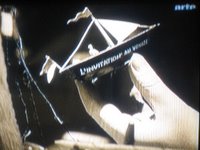
During the younger times of this Germanic count, Damen Germaine Dulac was a complete fräulein of strong character and independent spirit (even though she was Frenchified); well, it is what we, the aristocrats, used to consider as “dangerous longhaired youngsters”, because Damen Germaine Dulac had subversive and suspicious tendencies for the aristocracy, like being a specialist in Opera (and to make things worse, she liked it), a radical suffragist (those youngsters with revolutionary ideas), or theatre and cinema critic (this last thing is the worst, MEIN GOTT!). With such curriculum and bizarre taste, it was inevitable that she started to get interested by avant-garde film and became an exponent of it.
“L’Invitation Au Voyage” was made some years before “La Coquille Et Le Clergyman” (1928), her most well-known film which also maximises her restless cinematographic searches, a film that soon will be commented on by this Germanic count. In “L’Invitation Au Voyage”, she maintains a transgressor spirit and her eagerness to get at what she considered the “pure cinema”, even though the film is less risky and more accessible in its cinematographic proposals than “La Coquille Et Le Clergyman”.
At the beginning of the film, the stylistic intentions are very well defined when the director says that she expects with her film “to expose her cinematographic idea without the help of explicative signs”, so the image value gets hold of it on this film based on a Herr Baudelaire’s poem. The movie shows us in a special and nonconformist aesthetic and technic way, the frustrations and unrealised dreams of its main character in a port establishment (a magnificent multicolour ambience, a sea cabaret), her dreams as a livelihood for a false and dull life. The search of a chimera that even the main character is well aware of.
And now, if you allow me, I will leave you momentarily, because this Germanic Count has discovered, after a night of merrymaking in a port bar, that he has tattooed on his aristocratic arm an anchor!!!... a scandal that has to be fixed immediately, natürlich!
Herr Graf Ferdinand Von Galitzien
-/-
Damen Germaine Dulac, durante los tiempos mozos de éste Conde germánico, fue toda un fräulein de fuerte caracter y espíritu independiente ( y ello a pesar de ser afrancesada… ), vamos, lo que por entonces en la aristocracia considerábamos como “esos peligrosos jóvenes melenudos”, pues Damen Dulac tenía aficiones ciertamente subversivas y sospechosas para la aristocracia como el ser especialista en Ópera ( y gustarle, lo que la hace aún más peligrosa ), sufragista radical ( esas jóvenes con ideas revolucionarias ) o crítica de teatro y cine ( esto último es ya el colmo de los colmos, MEIN GOTT! ), con semejante currículo era entonces evidente que debido a tan bizarros gustos, comenzase entonces a interesarse por las vanguardias cinematográficas, convirtiéndose ella misma en todo un exponente de dicho movimiento.
“L’Invitation Au Voyage” está realizada unos años antes que “La Coquille Et Le Clergyman” (1928), su obra más conocida y máximo exponente de sus especiales inquietudes y búsquedas cinematográficas, un filme que será comentado próximamente por éste Conde germánico, manteniendo el primero, el espíritu trasgresor y sus ansias por conseguir lo que ella consideraba como el “cine puro”, aunque sea “L’Invitation Au Voyage” un filme muchísimo menos arriesgado y más accesible en sus propuestas cinematográficas que “La Coquille Et Le Clergyman”.
Las intenciones estilísticas quedan bien definidas al principios del filme al comentar la directora que pretende que su obra consiga “exponer su idea cinematográfica sin la ayuda de rótulos explicativos”, el valor de la imagen, consiguiéndolo plenamente en esta obra inspirada en un poema de Herr Baudelaire, en donde, de forma ciertamente especial y siempre inconformista tanto estética como técnicamente, nos muestra las frustraciones y deseos idealizados de su protagonista en un establecimiento porteño ( magnífico ambiente variopinto, un cabaret marítimo y canalla ), sueños como sustento para una vida anodina y falsa, la búsqueda de una quimera de la cual es incluso consciente la protagonista del filme.
Y ahora si me lo permiten les dejo momentáneamente, pues este Conde germánico ha descubierto, tras haber pasado una noche de juerga en una de esas tascas portuarias, que... ¡¡tiene tatuado un ancla en su brazo aristocrático!!..., un escándalo que hay que solucionar inmediatamente, natürlich!.
Herr Graf Ferdinand Von Galitzien

Keine Kommentare:
Kommentar veröffentlichen